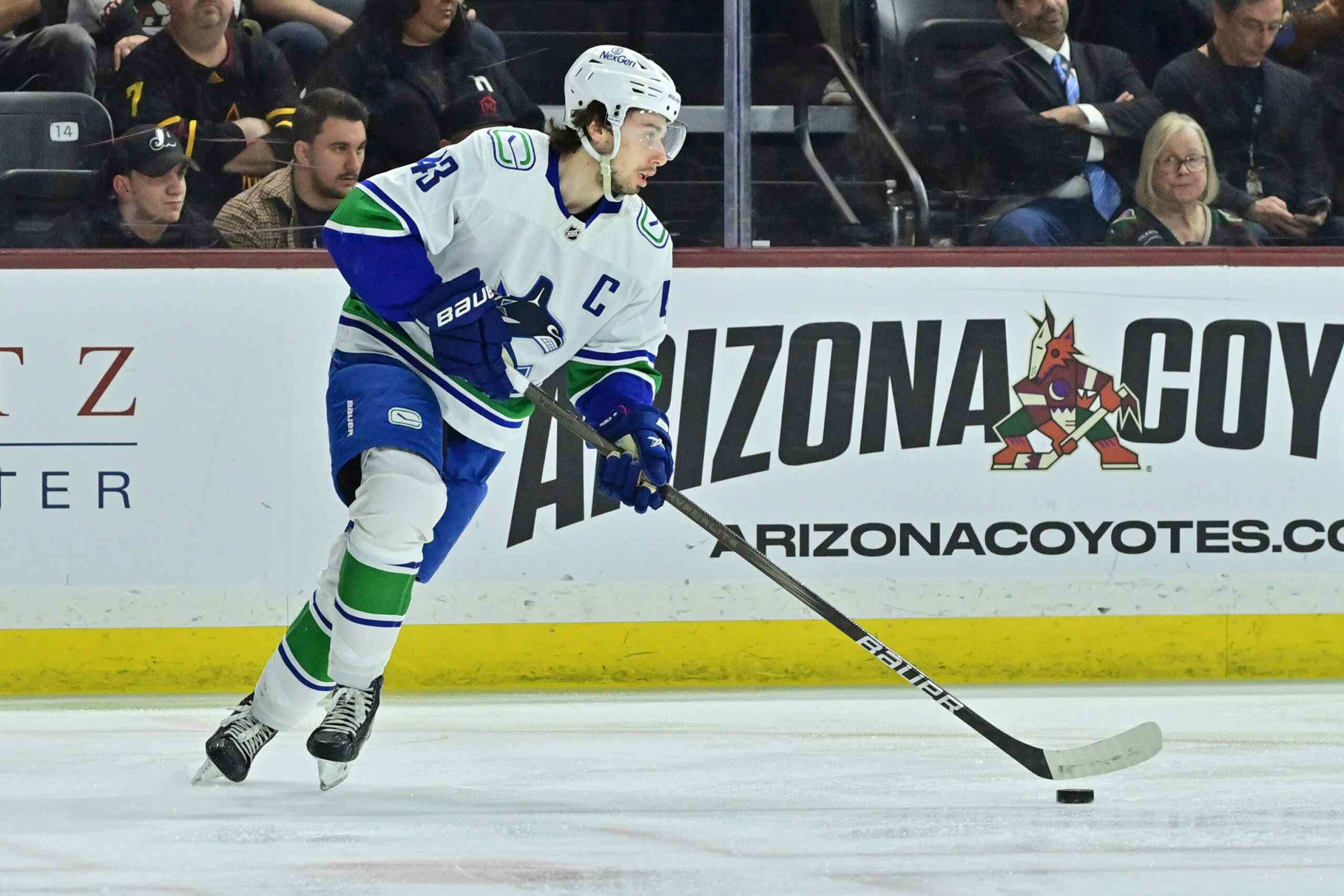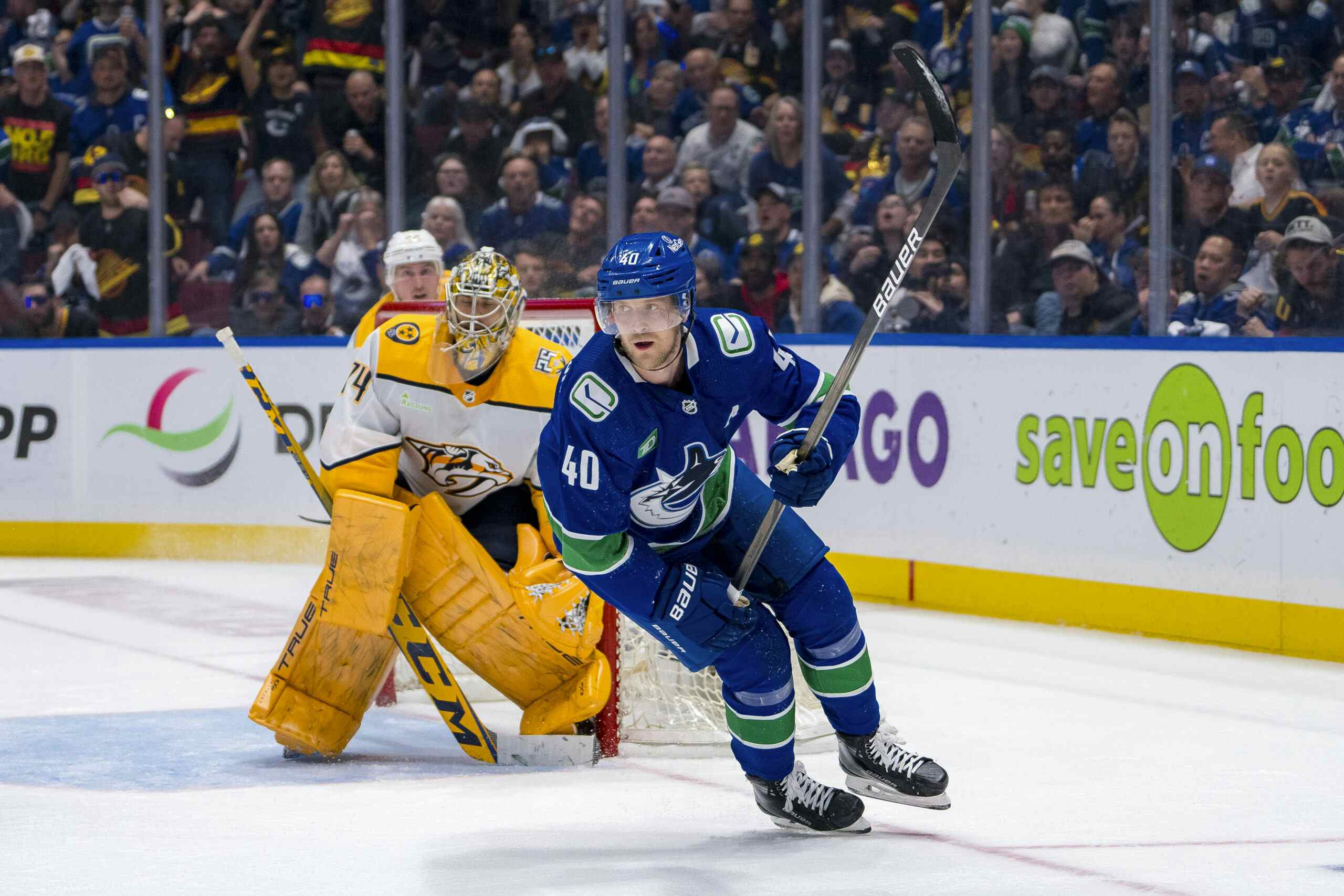Shorthanded Canucks Stump Toothless Coyotes in a Weird One

Jordan Schroeder celebrates his game winner with Mason Raymond and Kevin Bieksa.
(Photo by Christian Petersen/Getty Images)
In a game that featured two controversial goalie running incidents, Keith Ballard on the Canucks third line, and zero scoring chances from the Sedin-line – the Canucks somehow managed to pull out a regulation win in the comfy confines of Jobbing.com arena. Heh, Jobbing.com arena.
More immaturity, but also super technical analysis of Thursday night’s game, after the jump.
Let’s begin with an overview of the scoring chance data, shall we? Overall the Phoenix Coyotes had more premium scoring opportunities in this game than the Canucks did, tallying 14 scoring chances in aggregate to 9 for Vancouver. That looks bad for the Canucks, but most of that gap is a result of Phoenix’s solid work on the power-play on Thursday and at even-strength the ‘Yotes only out-chanced the Canucks 9-8.
Now before you go crediting Cory Schneider’s stellar play as the sole reason for Thursday night’s regulation victory, it’s worth noting that with the score tied the Canucks handled the chance battle to the tune of a five to two count. At even-strength the Coyotes narrowly controlled the run of play from a possession standpoint, but Vancouver’s defense effectively limited Arizona’s shots and quality chances. While the penalty-killing was a bit of a mess and the power-play continued to underwhelm, I’d say that the Canucks narrowly deserved to win this one.
Now let’s give credit where it’s due, because Cory Schneider was pretty damn good in this one. The obvious qualifier is that the Coyotes are a very limited offensive team, but still, Schneider made some lovely saves to bail out his teammates especially in the first half of the third period. Overall he stopped 33 of 34 shots and 10 of 11 "difficult shots," putting together an efficient performance in a victorious effort.
The Canucks opened the scoring early in the first period, as Canucks Army darlings Chris Tanev and Mason Raymond worked a give-and-go and set up a deadly Chris Tanev wrist shot that beat Mike Smith. Let’s watch!
Chris Tanev, baby!
From there the Canucks played mostly conservative hockey. In fact, Tanev’s goal was the last scoring chance in the first period for either team.
The second period was mostly more of the same, low-event hockey punctuated with a couple of interesting moments involving Daniel Sedin and Mike Smith and then Alex Edler and Mike Smith. First Daniel Sedin beat Coyotes defenseman Michael Stone on a break, but before he could get a shot off he was hooked and bowled into the ‘Yotes’ puck stopper. It was a massive colision and it left both players lying prone on the ice. Mike Smith took his time but eventually returned to action without missing any time, while Daniel Sedin went to the dressing room to take care of a nose bleed that was started when Mike Smith struck Daniel in the face with his blocker; the result of a defensive, reflex action he made while bracing for impact.
Obviously because Daniel Sedin is a Sedin twin, he missed a couple of shifts waiting for the profuse bleeding to come to a halt, and was then promptly back out on the ice handling the tough minutes with his brother and Alex Burrows. Daniel’s quick recovery was about as predictable as a hockey writer criticizing Alain Vigneault in the Province sports pages tomorrow for starting the wrong defenseman at forward. "After all, it was Chris Tanev who managed to score a goal."
The second "running Mike Smith" incident occurred later in the second period when, with the Canucks on the power-play, Alex Edler took some kind of crazy run at Smith as the former Marty Turco understudy played the puck behind his net. Edler was assessed a major penalty on the play, which confused me, and four mintues of game-time later the Coyotes managed to even the score while Edler sat in the penalty box.
In addition to what seemed like an oddly stiff major penalty call, there’s some chatter that Edler may face a supplementary discipline hearing on top of it. Mike Smith left the game in the third period and we’ve got no update on his status, but certainly if he’s hurt – and also because it was a major penalty – I’d expect the office of player safety to at least review the incident. My two cents: I’d be pretty surprised if Alex Edler recieved a shanaban for this play, though I guess if Mike Smith is legitimately hurt and the league decides to send a message about how serious they are about protecting goaltenders, it’s conceivable.
The Coyotes out-chanced the Canucks pretty handily in the third, though the Canucks actually controlled the territorial play despite leading throughout. Unsurprisingly the team’s best stretch came immediately after the Coyotes tied the game up, as the Canucks reeled off three scoring chances in a two minute span, including two Jordan Schroeder chances one of which broke the deadlock.
Good fun to see Jordan Schroeder rewarded with a goal. He’s been absolutely stellar since returning to the Canucks lineup earlier this week and I am pretty much convinced at this point that he’s a bonafide NHL player. Schroeder is being rewarded for his quality performance of late and not just with counting stats production. It seems to me that Alain Vigneault is parceling out more responsibility for the speedy rookie, and for the second straight game Jordan Schroeder was legitimately deployed as Vancouver’s second line center. Moreover, he was actually Vancouver’s best forward by the scoring chance data.
Jason Garrison and Dan Hamhuis had a tough outing in this one and were both pretty much crushed (along with the Sedin twins) while matched up primarily against the Shane Doan line. Meanwhile I think that might have been Kevin Bieksa’s best two-way game of the season and Alex Edler was solid as well (so long as he wasn’t stupidly running Mike Smith with his team on the power-play). Cam Barker and Chris Tanev didn’t play much, but they took advantage of what responsibility they were given, finishing in the black by both the possession and chance data.
The Canucks spent four and a half minutes short-handed on Thursday night, and surrendered five scoring chances against. That’s pretty bad – we usually expect an average power-play to generate a scoring chance every minute and a half – especially against a toothless Coyotes power-play group.
Vancouver’s equally toothless power-play only registered a single scoring chance for in nearly two and a half minutes of ice-time, which isn’t awful but it’s not particularly good either. Vancouver’s five-on-five play continues to impress me and while I probably should probably cut a short-handed club some slack after a pretty gutty regulation road win, I just can’t help myself: quite honestly, this iteration of the Canucks continues to look lost on special teams.
Let’s finish this gamer off with some notes on Keith Ballard as a forward. First of all he got more ice-time than Cam Barker did as a defenseman, so that’s neat. Secondly he finished in the black by the possession data and the chance data, flashed some speed on the forecheck and some skill on the rush and was two combined inches away from a two-point first period. First he was a half inch away from a secondary assist on an Andrew Ebbett chance at a chance in the first period. Later in the frame he danced around Derek Morris with a lovely inside-outside move, and sent a backhander on net that beat Mike Smith and hit the post. I’ll admit that I laughed heartily at that sequence.
In summary Ballard almost had a two point game, and if he has to suit up as a forward again on this road trip it looks to me like he’ll be able to handle it competently. With that sort of versatility, maybe Keith Ballard can become like the Canucks version of Ben Zobrist (but not nearly as valuable of course).
Scoring Chance Data
A chance is counted any time a team directs a shot cleanly on-net from within home-plate. Shots on goal and misses are counted, but blocked shots are not (unless the player who blocks the shot is “acting like a goaltender”). Generally speaking, we are more generous with the boundaries of home-plate if there is dangerous puck movement immediately preceding the scoring chance, or if the scoring chance is screened. If you want to get a visual handle on home-plate, check this image.
Scoring Chance Totals:
| Scoring Chance Totals | 1st | 2nd | 3rd | Total |
|---|---|---|---|---|
| Phoenix (EV) | 1 (1) | 4 (4) | 9 (4) | 14 (9) |
| Vancouver (EV) | 2 (2) | 3 (2) | 4 (4) | 9 (8) |
Individual Scoring Chance Contributions:
| Individual Chances | Taken | Created | Total |
|---|---|---|---|
| Mason Raymond | 1 | 2 | 3 |
| Jordan Schroeder | 2 | 0 | 2 |
| Dan Hamhuis | 1 | 1 | 2 |
| Chris Tanev | 1 | 0 | 1 |
| Cam Barker | 1 | 0 | 1 |
| Dale Weise | 1 | 0 | 1 |
| Alex Edler | 1 | 0 | 1 |
| Kevin Bieksa | 1 | 0 | 1 |
| Alex Burrows | 0 | 1 | 1 |
| Jannik Hansen | 0 | 1 | 1 |
Individual Scoring Chance Differential:
| Scoring Chances | EV F – A | PP F – A | SH F – A | Total F – A |
|---|---|---|---|---|
| Dan Hamhuis | 2 – 5 | 1 – 0 | 0 – 4 | 3 – 9 |
| Kevin Bieksa | 4 – 3 | 1 – 0 | 0 – 1 | 5 – 4 |
| Keith Ballard | 1 – 0 | 0 – 0 | 0 – 0 | 1 – 0 |
| Jason Garrison | 1 – 4 | 0 – 0 | 0 – 4 | 1 – 8 |
| Chris Tanev | 3 – 1 | 0 – 0 | 0 – 2 | 3 – 3 |
| Alex Burrows | 0 – 2 | 1 – 0 | 0 – 4 | 0 – 6 |
| Cam Barker | 3 – 0 | 0 – 0 | 0 – 0 | 3 – 0 |
| Mason Raymond | 6 – 5 | 1 – 0 | 0 – 1 | 7 – 6 |
| Daniel Sedin | 0 – 2 | 0 – 0 | 0 – 0 | 0 – 2 |
| Alex Edler | 3 – 3 | 0 – 0 | 0 – 0 | 3 – 3 |
| Andrew Ebbett | 0 – 1 | 0 – 0 | 0 – 2 | 0 – 3 |
| Tom Sestito | 1 – 1 | 0 – 0 | 0 – 0 | 1 – 1 |
| Dale Weise | 1 – 0 | 0 – 0 | 0 – 0 | 1 – 0 |
| Henrik Sedin | 1 – 3 | 0 – 0 | 0 – 0 | 1 – 3 |
| Jannik Hansen | 5 – 6 | 0 – 0 | 0 – 2 | 5 – 8 |
| Maxim Lapierre | 1 – 1 | 0 – 0 | 0 – 0 | 1 – 1 |
| Andrew Gordon | 1 – 1 | 0 – 1 | 0 – 0 | 1 – 1 |
| Jordan Schroeder | 6 – 4 | 1 – 0 | 0 – 0 | 6 – 4 |
Recent articles from Thomas Drance





